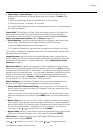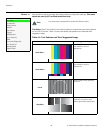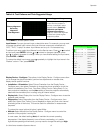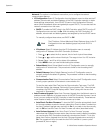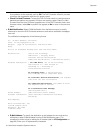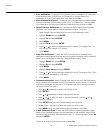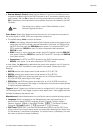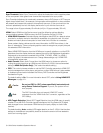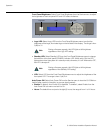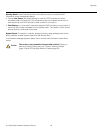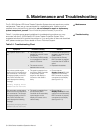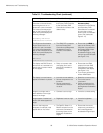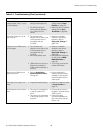
Operation
Q-1500d Series Installation/Operation Manual 93
PRE
L
IMINAR
Y
Sync Threshold: Select Sync Threshold to adjust the threshold at which negative pulses
on the component video green/luma channel are interpreted to be sync pulses.
Sync Threshold adjustment is occasionally necessary when a DVD player or HDTV source
signal drops “below black” (for example, during scenes with explosions or when subtitles
are present) and causes the projector to temporarily lose sync. If the sync level from the
source is persistently too low, the display device won’t sync with the source at all.
The range is from 0 (approximately 60 millivolts (mV)) to 15 (approximately 300 mV).
HDMI: Select HDMI from the Service menu to set the following options affecting
communication between HDMI sources, the DHD Controller and the Q-1500d.
• HDMI EDID Extension: Extended display identification data (EDID) is a data structure
provided by a display device to describe its capabilities to a graphics card. It is what
enables a modern personal computer to know what kind of monitor is connected.
Some modern display devices provide more information via EDID than others, in the
form of “extensions.” Some computer graphics cards do recognize or properly interpret
this extended EDID information.
Select HDMI EDID Extension from the HDMI menu to specify whether or not the EDID
extensions from the display device are passed through to the Brightness Acceleration
Engine and to the sources connected to the HDMI 1, HDMI 2, HDMI 3 or HDMI 4
inputs. By default, the extensions are on. Change these settings only if HDMI EDID
incompatibility issues arise.
•Audio Format: Select Audio Format from the HDMI menu to choose an option for
routing the audio signal from an HDMI source. With the Q-1500d, the recommended
setting is HDMI Out (Audio Only). (This is also the default setting.)
•CEC: This control chooses whether or not the DHD Controller responds to HDMI CEC
control messages from a disc player, set-top box or other HDMI source. It also enables
or disables communication between the Primary DHD Controller and the Brightness
Acceleration Engine.
The default setting is On. For more information about CEC, refer to Using HDMI CEC
Messages on page 121.
• HPD Toggle Rejection: Select HPD Toggle Rejection from the HDMI menu to specify
whether or not the DHD Controller ignores extraneous Hot Plug Detect (HPD) signal
state changes from a downstream HDMI device (third-party display or audio/video
receiver).
The default setting, Auto, enables HPD toggle rejection on the Q-1500d. Use the other
settings to troubleshoot compatibility issues or reduce the amount of time needed to
lock to an incoming signal.
Do not set CEC to “Off” unless specifically instructed to do
so by Runco Technical Support. If you do, the system will not
work properly.
The DHD Controller does not transmit HDMI CEC control
messages from the “HDMI Audio Out” connector, regardless of the
CEC setting.
Caution
Note



